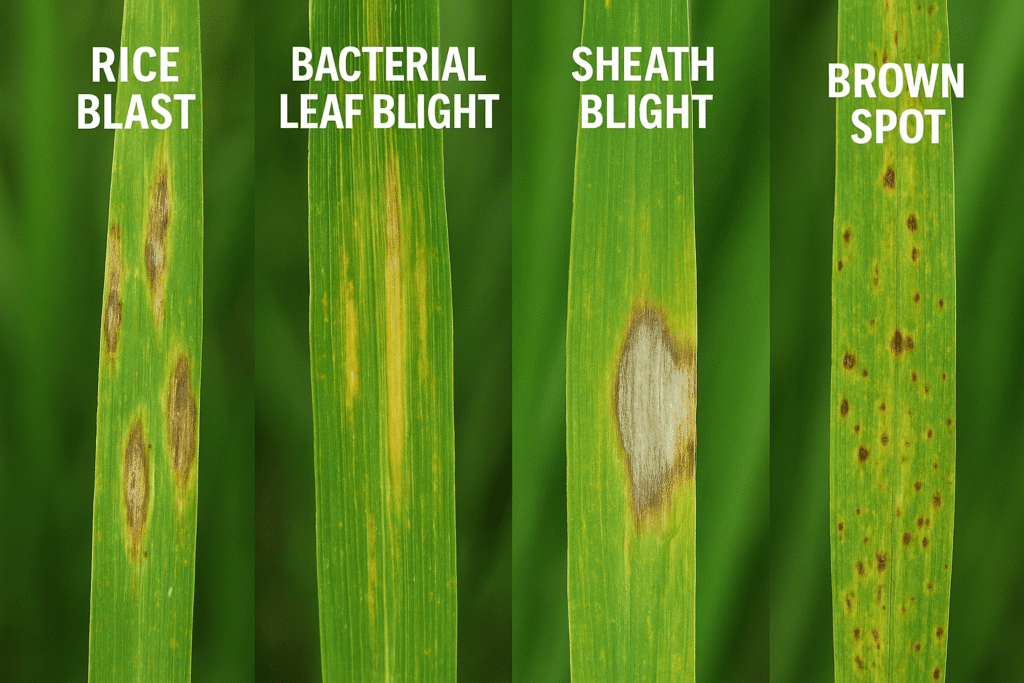
Table of Contents
ToggleIntroduction
Rice (Chawal) is one of Pakistan’s most important food and cash crops, grown extensively in Punjab, Sindh, and parts of Khyber Pakhtunkhwa. While improved varieties like Basmati, IRRI, and Hybrid have boosted yields, Diseases of Rice remain a major challenge for farmers. These diseases can reduce yields by 20–60%, lower grain quality, and increase production costs.
This guide explains the common diseases of rice in Pakistan, how to identify them, and the best integrated management practices to protect your crop.
Major Diseases of Rice in Pakistan
Fungal Diseases
1. Rice Blast (Magnaporthe oryzae)
Symptoms: Spindle-shaped lesions with gray centers and brown margins on leaves; neck rot at panicle stage causes empty grains.
Favorable Conditions: Warm, humid weather; excess nitrogen.
Management:
Use resistant varieties like Super Basmati.
Avoid excessive urea application.
Spray Tricyclazole 75% WP (6 g/10 L water) at early signs.
2. Bacterial Leaf Blight (Xanthomonas oryzae pv. oryzae)
Symptoms: Yellowing and drying of leaves starting from tips, bacterial ooze in humid conditions.
Favorable Conditions: High rainfall, irrigation water from infected fields.
Management:
Use disease-free seed.
Apply balanced fertilizer; avoid excess N.
Spray Streptomycin + Copper Oxychloride mixture.
3. Sheath Blight (Rhizoctonia solani)
Symptoms: Lesions on leaf sheaths near water level; can cause lodging.
Favorable Conditions: High humidity, dense planting.
Management:
Reduce plant density.
Maintain proper drainage.
Spray Validamycin 3% L or Carbendazim.
4. Brown Spot (Bipolaris oryzae)
Symptoms: Small circular brown lesions on leaves and grains; poor seedling growth.
Favorable Conditions: Drought stress, low soil fertility.
Management:
Apply balanced NPK.
Use disease-free seed.
Treat seed with Carbendazim 50% WP before sowing.
According to the International Rice Research Institute (IRRI), proper water management can reduce disease incidence.
Bacterial Diseases
Bacterial Leaf Streak
Symptoms: Narrow yellow to brown streaks between veins; bacterial ooze under high humidity.
Management:
Plant resistant varieties.
Avoid overhead irrigation.
Apply Copper-based fungicides.
Viral Diseases
Rice Tungro Disease
Symptoms: Stunted plants, yellow-orange leaves, reduced tillering.
Spread By: Green leafhopper insect vector.
Management:
Control leafhopper population with Imidacloprid.
Remove infected plants early.
Integrated Disease Management (IDM) for Rice in Pakistan
Cultural Practices
Rotate rice with non-host crops like wheat or maize.
Use recommended plant spacing to improve airflow.
Remove and destroy diseased stubble after harvest.
- Use balanced fertilizers
Seed Treatment
Treat seed with Carbendazim or Thiram before sowing.
Solarize seeds by drying under sunlight for 2 days.
Balanced Fertilization
Avoid overuse of nitrogen; follow Fertilizer Plan for Rice Crop.
Add potassium to strengthen plant resistance.
Resistant Varieties
Choose varieties with resistance to local diseases:
Super Basmati – blast tolerant.
IRRI-6 – bacterial leaf blight resistant.
Hybrid varieties – select those tested by PARC.
Timely Chemical Control
Monitor fields weekly during critical growth stages.
Use fungicides and bactericides at the first sign of infection.
Disease Calendar for Pakistani Rice Fields
| Growth Stage | Possible Diseases | Management Action |
|---|---|---|
| Seedling | Brown Spot, Blast | Seed treatment, balanced fertilization |
| Tillering | Blast, Sheath Blight | Avoid excess N, maintain water level |
| Panicle Initiation | Blast, Bacterial Leaf Blight | Spray fungicide/bactericide |
| Grain Filling | Sheath Blight, Brown Spot | Foliar spray potassium nitrate |
Variety Wise Disease Susceptibility Table
| Variety | BLB | Blast | Sheath Blight | Stem Rot | False Smut | Tungro |
|---|---|---|---|---|---|---|
| Super Basmati | High | Mod | Susc | Low | Mod | Low |
| Basmati 515 | Susc | Low | Susc | Low | Mod | Low |
| Basmati 2000 | Mod | Low | Mod | Low | Low | Low |
| IRRI-6 | High | Low | High | Mod | Low | Low |
| IRRI-9 | High | Low | High | Mod | Low | Low |
| KSK-133 | Mod | Mod | High | Low | Low | Low |
| Hybrid (Imp) | V.High | High | V.High | High | High | Low |
| Hybrid (Local) | High | Mod | High | Mod | Mod | Low |
High / V.High / Susc = Susceptible (needs strict control)
Mod = Moderate resistance
Low = Low susceptibility (better resistance)
| Variety | BLB | Blast | Sheath Blight | Stem Rot | False Smut | Tungro |
|---|---|---|---|---|---|---|
| Super Basmati | High | Mod | Susc | Low | Mod | Low |
| Basmati 515 | Susc | Low | Susc | Low | Mod | Low |
| Basmati 2000 | Mod | Low | Mod | Low | Low | Low |
| IRRI-6 | High | Low | High | Mod | Low | Low |
| IRRI-9 | High | Low | High | Mod | Low | Low |
| KSK-133 | Mod | Mod | High | Low | Low | Low |
| Hybrid (Imported) | V.High | High | V.High | High | High | Low |
| Hybrid (Local) | High | Mod | High | Mod | Mod | Low |
Cost of Disease Damage
On average, Diseases of Rice can cause:
Blast: 30–40% yield loss in severe cases.
Bacterial Leaf Blight: 20–30% loss.
Sheath Blight: 15–20% loss.
For a farmer producing 70 maunds/acre, blast alone can cause a loss of PKR 63,000–84,000 at PKR 3,000/maund.
Farmer Tips for Preventing Rice Diseases
Always use certified seed.
Follow proper water management.
Avoid working in wet fields when plants are diseased.
Monitor fields weekly for early symptoms.
Train workers to identify key diseases.
Conclusion
Managing Diseases of Rice in Pakistan requires a proactive approach that combines resistant varieties, balanced fertilizer use, timely chemical application, and cultural practices. By adopting Integrated Disease Management, farmers can protect their crops, improve yields, and secure higher profits. Disease control is not just about spraying chemicals—it’s about creating a healthy crop environment.
For a complete overview, check our full guide on Rice in Pakistan: Agronomy, Diseases, and Value Chain.”